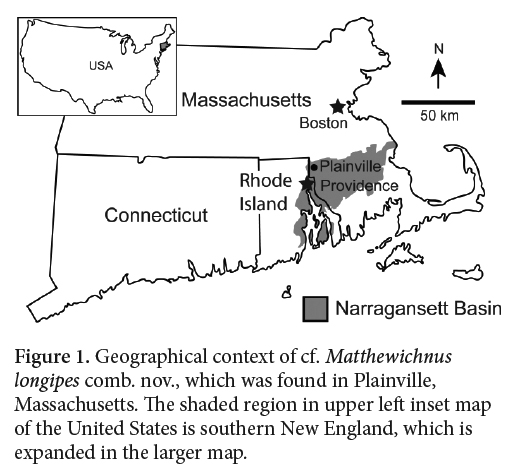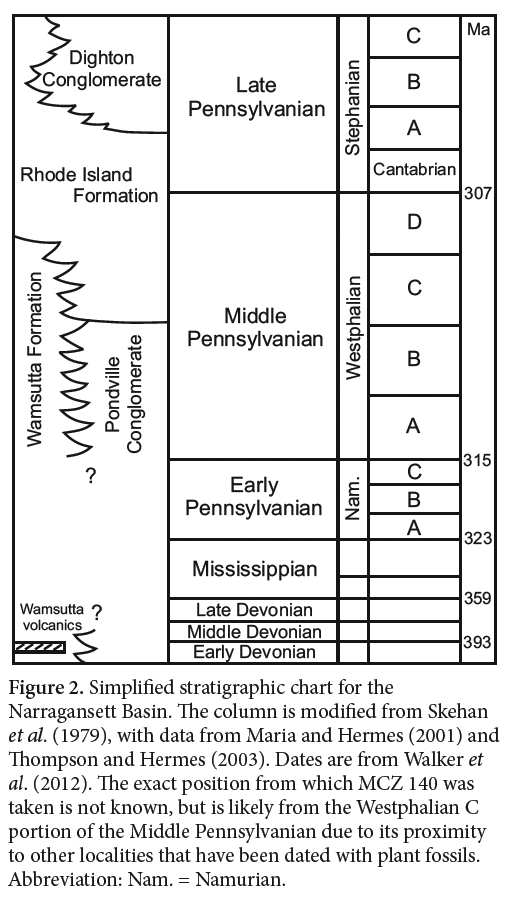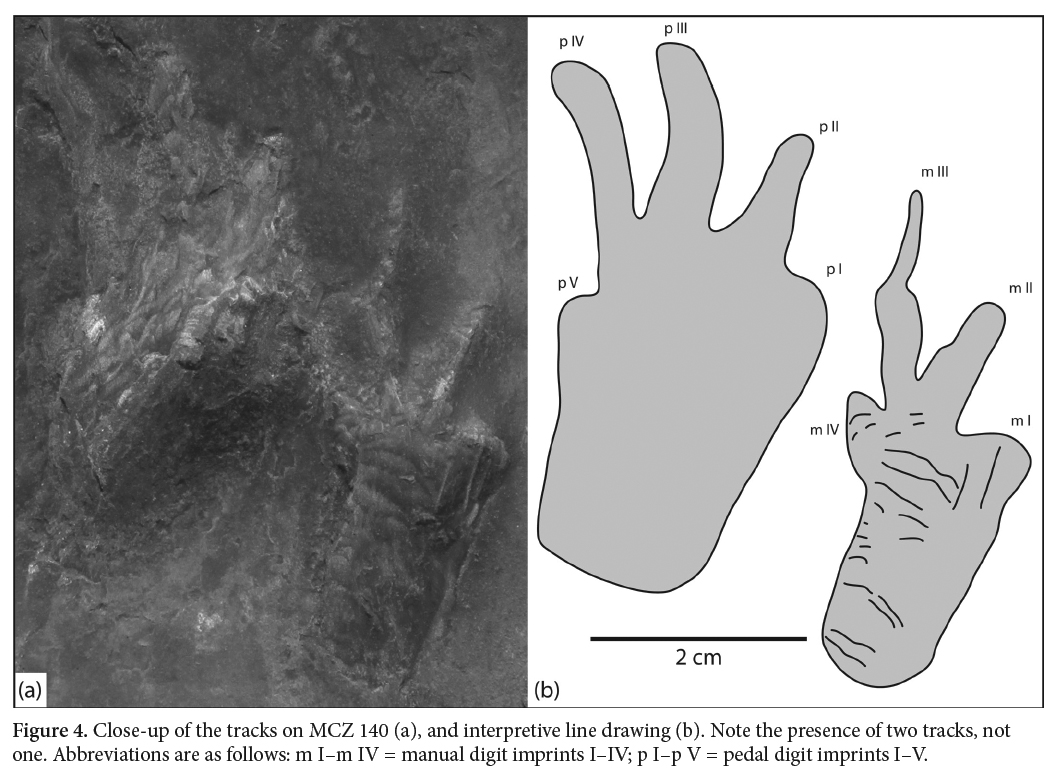Articles
Megapezia longipes Willard and Cleaves 1930 from the Pennsylvanian Rhode Island Formation of Massachusetts:
ichnotaxonomic status
ABSTRACT
The type and only specimen of the ichnospecies Megapezia longipes, from the Pennsylvanian Rhode Island Formation of Plainville, Massachusetts, consists of two poorly defined tracks, one made by a manus and the other by a pes, rather than a single pedal imprint. Whereas the type species of Megapezia, Megapezia pineoi, has tetradactyl pedal imprints, the pes imprint of Megapezia longipes is pentadactyl, a feature that precludes assignment to this ichnogenus. Rather, the tracks share two characteristics with the ichnogenus Matthewichnus, namely elongate digits II and III on the manus, and a pes imprint oriented anterolaterally to the manus imprint, and are thus tentatively reassigned to that ichnogenus. Cf. Matthewichnus longipes is retained as a separate ichnospecies pending the collection of additional material that can be compared with other species within the ichnogenus. With the tentative reassignment of the Plainville tracks to Matthewichnus, Megapezia becomes monospecific and is no longer recorded in New England. The tracks are the first known occurrence of Matthewichnus from this region.
RÉSUMÉ
Ce type et seul spécimen de l’ichnoespèce Megapezia longipes, de la formation pennsylvanienne du Rhode Island à Plainville, au Massachusetts, est composé de deux pistes mal définies, l’une provenant d’un membre antérieur et l’autre, d’un membre postérieur, plutôt que d’une empreinte de patte unique. Alors que l’espèce type Megapezia, Megapezia pineoi a des empreintes de pattes tétradactyles, l’empreinte de membre postérieur de Megapezia longipes est pentadactyle, une caractéristique qui exclut l’attribution à cet ichnogenre. Les pistes partagent plutôt deux caractéristiques avec l’ichnogenre Matthewichnus, à savoir des doigts II et III allongés au membre antérieur, et une empreinte de membre postérieur orientée de façon antérolatérale par rapport à l’empreinte de membre antérieur, ce qui amène à les réaffecter provisoirement à cet ichnogenre. Cf. Matthewichnus longipes demeure une ichnoespèce distincte dans l’attende de la collecte d’éléments supplémentaires, que l’on pourra comparer à d’autres espèces appartenant à cet ichnogenre. Compte tenu de la réaffectation provisoire des pistes de Plainville à Matthewichnus, Megapezia devient monospécifique et n’est plus recensée en Nouvelle-Angleterre. Les pistes constituent la première occurrence connue de Matthewichnus dans cette région.
[Traduit par la redaction]
INTRODUCTION
1 Matthew (1903) established the ichnogenus Megapezia for tracks from the Mississippian Horton Group of Parrsboro, Nova Scotia, Canada. Later, Willard and Cleaves (1930) erected a new ichnospecies, Megapezia longipes, for a vertebrate trace that was found in the Pennsylvanian Rhode Island Formation of Plainville, Massachusetts, USA. These authors described and figured the fossil, which made the name available according to Article 12 of the International Code of Zoological Nomenclature (Ride et al. 1999); but the description did not include justification for assigning the fossil to Megapezia. Additionally, Willard and Cleaves (1930) provided a photograph of Megapezia longipes but no interpretive drawing, which makes the written description difficult to follow.
2 No additional specimens have been assigned to Megapezia longipes in the nearly 90 years since it was described, and thus the taxon is based entirely on the holotype. Haubold (1970, 1971) questioned the assignment of the species to Megapezia. To address Haubold’s concern about the ichnogeneric status of Megapezia longipes, this paper presents the results of a reexamination of the holotype, including a more detailed description and interpretation, together with new photographs accompanied by interpretive line drawings. The evidence presented indicates that the specimen does not belong to Megapezia, but is better assigned, at least provisionally, to the ichnogenus Matthewichnus.
GEOLOGICAL AND PALEONTOLOGICAL CONTEXT
3 The fossil described by Willard and Cleaves (1930) was collected from rocks of the Rhode Island Formation, which is an approximately 3000 m thick sedimentary unit within the Narragansett Basin (Fig. 1). There are two hypotheses regarding the origin of the basin. Mosher (1983) proposed that it formed during sinistral motion as Laurentia and Avalonia collided, whereas Wintsch and Sutter (1986) argued that the basin formed during late Paleozoic thrust faulting in south-central New England. Most researchers (e.g., Shaler et al. 1899; Towe 1959; Quinn and Oliver 1962; Skehan et al. 1979; Mosher 1983) consider the basin to be of Pennsylvanian age based on plant fossils, but radiometric dating of rhyolite near the base of the basin fill suggests that extension began in the Devonian (Maria and Hermes 2001; Thompson and Hermes 2003; Fig. 2).
 Display large image of Figure 1
Display large image of Figure 1
 Display large image of Figure 2
Display large image of Figure 2
4 Towe (1959) argued that the sedimentary rocks of the basin were formed in an alluvial fan system with meandering streams, floodplains, and swamps. Fossiliferous rocks near Plainville include fine-grained sandstone, siltstone, shale, and coal, and are considered low-energy interchannel, swamp, and floodplain deposits (Towe, 1959; S. Voigt, personal communication, 2010). The slab on which the tracks were preserved is composed of dark-grey shale and lacks desiccation cracks or any other indicator of subaerial exposure, which suggests that the sediment was deposited in an aquatic environment.
5 Narragansett Basin rocks were deformed and metamorphosed to differing degrees during the Alleghanian orogeny (Skehan et al. 1979; Mosher 1983; Murray et al. 2004; Hatcher 2010). The northern part of the basin, where Megapezia longipes was collected, experienced low grade, sub-greenschist-facies metamorphism, as evidenced by mineral assemblages and coal rank (Skehan et al. 1979; Murray et al. 2004; Connell 2006; Kirkwood 2006). Trace fossils collected in Plainville are visibly deformed (Willard and Cleaves 1930; Fichman et al. 2015).
6 The flora and fauna in Carboniferous strata around Plainville are quite diverse. Oleksyshyn (1976) reported a Westphalian C flora of 27 species from a quarry near where Megapezia longipes was found. Animal fossils from this quarry are restricted to traces. Invertebrate traces include Cochlichnus anguineus, Diplichnites cuithensis, Diplichnites gouldi, Diplopodichnus biformis, Gordia carickensis, Helminthoidichites tenuis, Lockeia isp., Planolites isp., Siskemia elegans, Stiallia pilosa, Stiaria intermedia, Tonganoxichnus buildexensis and Umfolozia sinuosa (Getty et al. 2013; personal observations). Vertebrates are represented by Undichna unisulca, Undichna isp., Batrachichnus plainvillensis, and Characichnos tridactylus, and Notalacerta missouriensis (Woodworth 1900; Fichman et al. 2015).
MATERIALS AND METHODS
7 The holotype of Megapezia longipes was originally housed at Brown University (Willard and Cleaves 1930), but it is now at the Museum of Comparative Zoology at Harvard University, where it bears specimen number MCZ 140. The specimen was examined and photographed for the present study under low-angle light. The photographs were imported into the public-domain image processing and analysis program ImageJ (Rasband 1997–2004) in order to obtain track measurements, including length, width and angle of divarication. Due to deformation, however, the track measurements reported herein are approximations of those of the original track.
SYSTEMATIC ICHNOLOGY
Ichnogenus Matthewichnus Haubold 1970
8 TYPE SPECIES: Matthewichnus velox Matthew 1905
9 DIAGNOSIS: Quadrupedal, plantigrade tetrapod trackway with tetradactyl manus and pentadactyl pes imprints. Manus is approximately as wide as long and is much smaller than pes. Manus digits II and III approximately equal in length and elongate, slightly more than half the length of the entire print. Digits I and IV of manus approximately one third the length of the entire print. Pes digits increase in length from I to IV, with digits III and V being approximately equal in length. (Modified from Haubold et al. 2005.).
10 REMARKS: Matthewichnus is similar in gross morphology to the ichnogenera Batrachichnus and Limnopus. Voigt and Lucas (2015), for example, noted that Matthewichnus caudifer is indistinguishable from Batrachichnus salamandroides based solely on the morphology of the tracks. Fillmore et al. (2012), however, noted that Matthewichnus can be differentiated from Batrachichnus and Limnopus by the much smaller manus track than pes track. Further morphological differences between Matthewichnus and Batrachichnus include the presence of elongate digits II and III on the manus and a more irregular placement of manus and pes imprints within the trackway (Kohl and Bryan 1994; Haubold et al. 2005; Fillmore et al. 2012; Voigt and Haubold 2015; Voigt and Lucas 2015).
cf. Matthewichnus longipes Willard and Cleaves 1930 comb. nov.
(Figures 3–4)- 1930 Megapezia longipes; Willard and Cleaves, p. 324, pl. 4, fig. 1.
- 1970 ? Megapezia longipes; Haubold, p. 94.
- 1971 ? Megapezia longipes; Haubold, p. 14.
- 1995 Megapezia longipes; Cotton et al., p. 201, fig. 8B, table 1.
- 2007 Megapezia; Lucas, p. 9.
 Display large image of Figure 3
Display large image of Figure 3
 Display large image of Figure 4
Display large image of Figure 4
12 MATERIAL: Holotype ― MCZ 140, housed at the Museum of Comparative Zoology at Harvard University.
13 OCCURRENCE: Late Carboniferous (Pennsylvanian), Rhode Island Formation.
14 DESCRIPTION: Two tracks are preserved side by side in concave epirelief on the slab. They are separated by a nearly continuous area of rock at the same elevation as the rest of the slab. The track on the right is smaller, tetradactyl, and slightly longer than wide. It exhibits a long, rectangular imprint proximal to the digit imprints. The track measures 40 mm long (26 mm without the proximal rectangular imprint) by 22 mm wide. The digit imprints, which are counted from right to left, are in general straight, although the third digit exhibits a bend along its length. All have rounded distal terminations. Digits I and IV measure 5 mm long, or about one-fifth the length of the track. Digits II and III 10 mm and 12 mm, or 38–46% the length of the track. The total angle of divarication between the digits is 113°, and the angles of divarication between the successive digits are as follows: I–II = 54°, II–III = 33°, and III–IV = 28°. The track exhibits a pronounced transverse wrinkling that is especially well developed in the region between the digits and the rectangular imprint.
15 The larger track, on the left, is pentadactyl and is nearly twice the length of the tetradactyl track. It measures 50 mm long by 20 mm wide. A broad, ovate imprint measuring 23 mm long by 18 mm wide is located proximal to the digit imprints, which are less well defined than those in the other track. Digit imprints are counted from right to left. Digits I and V are short, measuring approximately 5 and 4 mm long, respectively. Both appear as small, subtly rounded projections on the sides of the track. Imprints of digits II, III and IV are relatively long, measuring 11 mm, 15 mm, and 16 mm, respectively. The imprint of digit II is approximately straight, whereas those of digits III and IV curve and are concave to the left. All of the digits are of relatively uniform thickness and have rounded terminations. The total angle of divarication is 60°; the angles of divarication between the successive digits are as follows: I–II = 28°; II–III = 21°; III–IV = 10°; and IV–V= 9°.
16 REMARKS: The two tracks on MCZ 140 are here interpreted as having been made by a manus and pes. The smaller, tetradactyl track is inferred to be that of the manus, whereas the larger pentadactyl track is that of the pes. The serial increase in length from right to left in the first four digits of the pes track indicates that it was made by a left foot. Considering the close proximity of the tracks, along with their similar orientation, it seems likely that they were made by the same animal as a manus-pes set. If that were true, then the tetradactyl track would be that of the left manus. It is possible, however, that the tracks were made by two different individuals traveling in the same direction. The tracks were probably made in wet mud, as is evidenced by the presence of the rectangular imprint (which was likely made by the antebrachium, or forearm) associated with that of the manus, the deep digit imprints of the manus, and the poorly defined and strongly curved digits of the pes imprint. Similar tracks from Argentina have also been interpreted as being produced in saturated sediment (Melchor and Sarjeant 2004).
17 When Willard and Cleaves (1930) described Megapezia longipes, they interpreted the fossil to include only a single, pentadactyl imprint that they thought was made by the left hind foot. These authors clearly stated that they thought the manus imprint was lacking. Considering that the ichnogenus Megapezia was established for a trackway with tetradactyl pedal imprints (Matthew 1903), Willard and Cleaves’ specimen should not have been assigned to Megapezia. The reinterpretation of the specimen here as being composed of both manus and pes imprints does nothing to change this assessment since the correctly identified pes is also pentadactyl.
18 Rather than Megapezia, the tracks on MCZ 140 are more similar in morphology to the ichnogenera Batrachichnus, Limnopus, and Matthewichnus, all of which have tetradactyl manus tracks and pentadactyl pes tracks (Marsh 1894; Woodworth 1900; Baird 1952; Haubold 1970; Kohl and Bryan 1994; Tucker and Smith 2004). Various features of the tracks, however, suggest that they are more appropriately assigned to Matthewichnus. For example, the manus track is much smaller than the pes track. Furthermore, digit impressions II and III of the manus are relatively long, although not as long as is often cited for Matthewichnus. Finally, as in some specimens of Matthewichnus (e.g., Voigt and Lucas 2015, fig. 2B), the pes imprint on MCZ 140 is situated anterolaterally to that of the manus. The poor definition of the tracks and the lack of a complete trackway, however, argue against a definitive ichnogeneric reassignment (Bertling et al. 2006). Consequently, the tracks on MCZ 140 are provisionally reassigned to Matthewichnus. The ichnospecies cf. Matthewichnus longipes is, however, not synonymized with any other ichnospecies within Matthewichnus pending the collection of additional material that can be compared with other species within the ichnogenus.
DISCUSSION
19 Considering that MCZ 140 was until now the only specimen assigned to Megapezia from New England, the reassignment of the tracks to Matthewichnus, albeit tentatively, means that Megapezia is no longer recognized in this region (cf. Cotton et al. 1995; Lucas 2007). Furthermore, since Megapezia longipes was the only valid ichnospecies of Megapezia other than the type, the ichnogenus is now restricted to the type species, Megapezia pineoi, from the Mississippian of Nova Scotia.
20 Haubold (1970) reassigned Lull’s (1920) species Dromopus? woodworthi, also from the Narragansett Basin, to Matthewichnus. This reassignment would make MCZ 140 the second occurrence of Matthewichnus within the Narragansett Basin. Fillmore et al. (2012), however, were skeptical of including Dromopus? woodworthi in Matthewichnus. Unlike typical Matthewichnus tracks, which have rounded tips to the digit imprints (Voigt and Lucas 2015), Dromopus? woodworthi has distinctive toe-pad and claw imprints. Thus the inclusion of Dromopus? woodworthi in Matthewichnus is not accepted herein and MCZ 140 is considered the first tentative occurrence of Matthewichnus within the Narragansett Basin.
I thank Jessica Cundiff, Acting Collection Manager at the Museum of Comparative Zoology, for granting me permission to study MCZ 140 and other specimens in her care. I also thank Meredith Fichman, Richard Knecht, and Robert Sproule for assistance at the museum. Thanks are due to Andrew Bush for lending his camera for photography. Robert Sproule is also acknowledged for providing comments on early drafts of the manuscript. Reviews by Matt Stimson and Spencer Lucas, along with editorial comments by Rob Fensome, greatly improved the final draft.